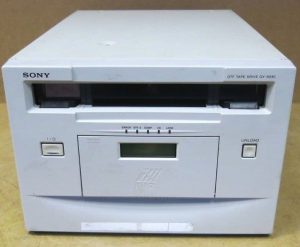History (1998): Sony DTF Tape Roadmap
84GB/24MB/s next year, then 168/24 followed by 386/48
By Jean Jacques Maleval | March 22, 2022 at 2:01 pmThe DTF (Digital Tape Format) format from Sony is derived from a helical scan Betacam that dates back to 1982, and is in fact still offered by the company’s broadcast and professional systems division, an not by the 8mm AIT team.

It was launched in 1995, on the heels of the D1 format. DTF is built around a cartridge containing a metal particle tape a half-inch in width with uncompressed capacity of 12 or 42GB, depending on whether the cassette is small or large.
The compression ratio is 1:2.6, according to Sony, thanks to the use of IBM’s ADLC algorithm.
In the words of Tatsumi Igari, manager, data recorder section, communication systems marketing department, marketing division, broadcasting and professional systems company, it sells “in the range of thousands of drives” throughout the world.
This is very little, when you consider the number of years this device has been offered, but quite a lot in light of the high cost of the GY-2120 drive, currently running about $25,000 – even if it’s dropping – and the cost of the cassette (around $100 for the large one).
Sony started selling via OEMs like TTi, Cybernetics, Emass, Hitachi and Digital, explains Igari. For a year now, it is sold through distributors under the Sony brand name.
In addition to its considerable capacity, DTF benefits from an excellent transfer rate, native sustained 12MB/s, 20MB/s with DC. The 18kg drive contains a 32MB buffer. Search speed is 300MB/s.
Users of this kind of technology are generally those with specific capacity and speed requirements.
Igari also points out that his biggest user, with a 200TB system, is a firm in Japan that engages in R&D in physics.
A good number of DTF drives are integrated in autoloaders (the 9 cartridge DMS-B9, for a maximum of 378GB) or in automatic libraries (DMSB35, with 35 large or 70 small cassettes, with 1 or 2 drives, DMS-8400 with capacities ranging from 5.4TB to 2.3PB with up to 828 drives!).
For this product, Sony’s roadmap anticipates several stages. In theory, next year will see the launch of the DTF-2 (84GB, 24MB/s) with a drive that can read and write current DTF-1 cassettes. The FC interface should also be offered in addition to SCSI-2 F/W, as it is today.
The subsequent stages, with no date yet announced, should be 168/24 followed by 386/48.
This article is an abstract of news published on issue 129 on October 1998 from the former paper version of Computer Data Storage Newsletter.













 Subscribe to our free daily newsletter
Subscribe to our free daily newsletter

